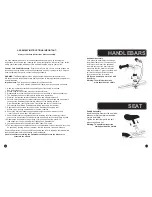
ENGLISH
89 |
ROAD BIKE |
OWNER’S MANUAL 2021
e
f
d
Pay particular attention when switching to the small gears, making sure the
rear derailleur does not get too close to the spokes as the chain climbs onto
the larger sprockets
(e)
.
If the rear derailleur or the drop-outs/derailleur hanger is bent, the rear derail-
leur may collide with the spokes. This in turn can destroy the rear derailleur,
the rear wheel or the frame. Check the function of the front derailleur, as a
displaced front derailleur can throw off the chain, thus interrupting the drive
of your SCOTT bike. Risk of falling!
For more information see the chapter “Gears” and the manuals of the compo-
nent manufacturers.
4. Make sure the saddle is not out of alignment
(f)
using the top tube or the
bottom bracket shell as a reference. If necessary, open the clamping, realign
the saddle and retighten the clamping.
For more information see the chapters “Adjusting the SCOTT bike to the rid-
er” and “Using quick-releases and thru axles” and the manuals of the compo-
nent manufacturers.
5. Let your SCOTT bike bounce on the ground from a small height. If there is any
rattling, check where it comes from. Check the bearings and bolted connec-
tions, if necessary. Tighten them slightly, if necessary.
6. Finally, take a good look at the whole SCOTT bike to detect any deformations,
colour changes or cracks.
WARNING
Ride back very carefully by taking the shortest route possible, even if your
SCOTT bike went through this check without any problems. Do not accel-
erate or brake hard and do not ride your bike out of the saddle. If you are in
doubt about the performance of your SCOTT bike, have yourself picked up
by car instead of taking any risk.
Back home you need to check your SCOTT bike thoroughly. Damaged parts
must be repaired or replaced. Ask your SCOTT dealer for advice. For more
information on carbon components see the chapter “Carbon – a particular
material” and the manuals of the component manufacturers.
















































